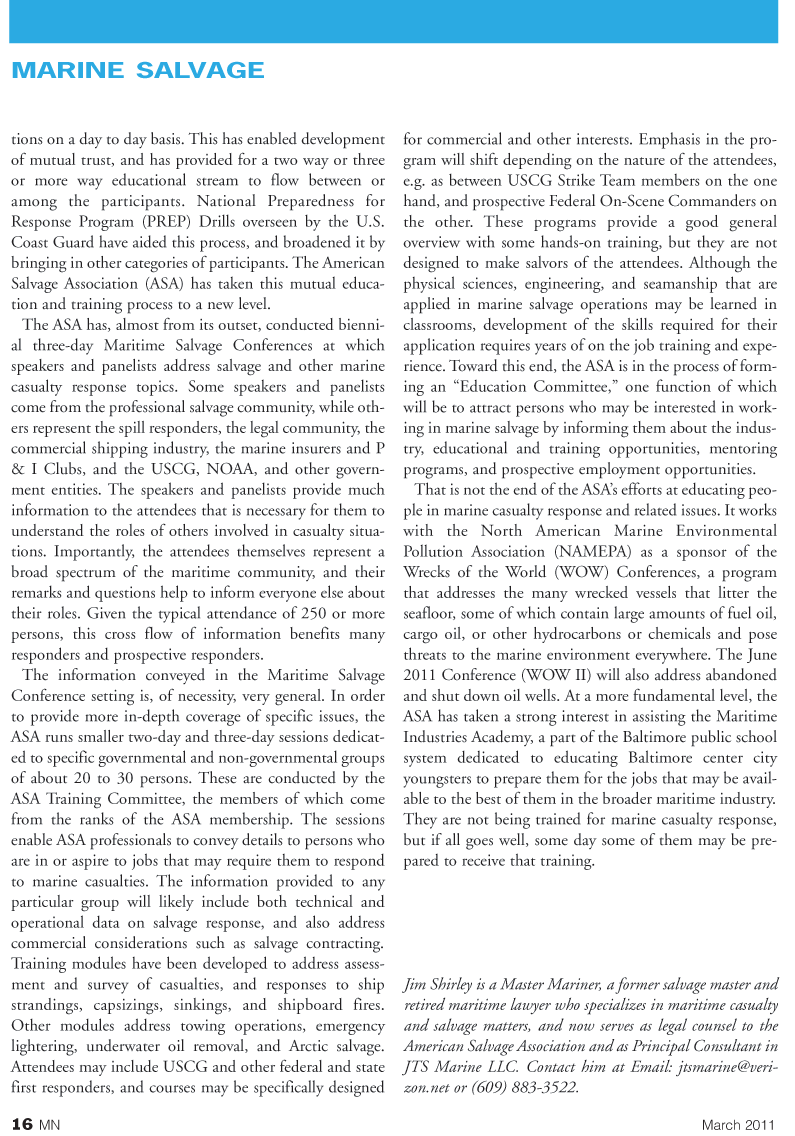
Page 16: of Marine News Magazine (March 2011)
Marine Training & Education Edition
Read this page in Pdf, Flash or Html5 edition of March 2011 Marine News Magazine
MARINE SALVAGE tions on a day to day basis. This has enabled development of mutual trust, and has provided for a two way or three or more way educational stream to flow between or among the participants. National Preparedness for
Response Program (PREP) Drills overseen by the U.S.
Coast Guard have aided this process, and broadened it by bringing in other categories of participants. The American
Salvage Association (ASA) has taken this mutual educa- tion and training process to a new level.
The ASA has, almost from its outset, conducted bienni- al three-day Maritime Salvage Conferences at which speakers and panelists address salvage and other marine casualty response topics. Some speakers and panelists come from the professional salvage community, while oth- ers represent the spill responders, the legal community, the commercial shipping industry, the marine insurers and P & I Clubs, and the USCG, NOAA, and other govern- ment entities. The speakers and panelists provide much information to the attendees that is necessary for them to understand the roles of others involved in casualty situa- tions. Importantly, the attendees themselves represent a broad spectrum of the maritime community, and their remarks and questions help to inform everyone else about their roles. Given the typical attendance of 250 or more persons, this cross flow of information benefits many responders and prospective responders.
The information conveyed in the Maritime Salvage
Conference setting is, of necessity, very general. In order to provide more in-depth coverage of specific issues, the
ASA runs smaller two-day and three-day sessions dedicat- ed to specific governmental and non-governmental groups of about 20 to 30 persons. These are conducted by the
ASA Training Committee, the members of which come from the ranks of the ASA membership. The sessions enable ASA professionals to convey details to persons who are in or aspire to jobs that may require them to respond to marine casualties. The information provided to any particular group will likely include both technical and operational data on salvage response, and also address commercial considerations such as salvage contracting.
Training modules have been developed to address assess- ment and survey of casualties, and responses to ship strandings, capsizings, sinkings, and shipboard fires.
Other modules address towing operations, emergency lightering, underwater oil removal, and Arctic salvage.
Attendees may include USCG and other federal and state first responders, and courses may be specifically designed for commercial and other interests. Emphasis in the pro- gram will shift depending on the nature of the attendees, e.g. as between USCG Strike Team members on the one hand, and prospective Federal On-Scene Commanders on the other. These programs provide a good general overview with some hands-on training, but they are not designed to make salvors of the attendees. Although the physical sciences, engineering, and seamanship that are applied in marine salvage operations may be learned in classrooms, development of the skills required for their application requires years of on the job training and expe- rience. Toward this end, the ASA is in the process of form- ing an “Education Committee,” one function of which will be to attract persons who may be interested in work- ing in marine salvage by informing them about the indus- try, educational and training opportunities, mentoring programs, and prospective employment opportunities.
That is not the end of the ASA’s efforts at educating peo- ple in marine casualty response and related issues. It works with the North American Marine Environmental
Pollution Association (NAMEPA) as a sponsor of the
Wrecks of the World (WOW) Conferences, a program that addresses the many wrecked vessels that litter the seafloor, some of which contain large amounts of fuel oil, cargo oil, or other hydrocarbons or chemicals and pose threats to the marine environment everywhere. The June 2011 Conference (WOW II) will also address abandoned and shut down oil wells. At a more fundamental level, the
ASA has taken a strong interest in assisting the Maritime
Industries Academy, a part of the Baltimore public school system dedicated to educating Baltimore center city youngsters to prepare them for the jobs that may be avail- able to the best of them in the broader maritime industry.
They are not being trained for marine casualty response, but if all goes well, some day some of them may be pre- pared to receive that training.
Jim Shirley is a Master Mariner, a former salvage master and retired maritime lawyer who specializes in maritime casualty and salvage matters, and now serves as legal counsel to the
American Salvage Association and as Principal Consultant in
JTS Marine LLC. Contact him at Email: jtsmarine@veri- zon.net or (609) 883-3522. 16 MN March 2011

 15
15

 17
17
